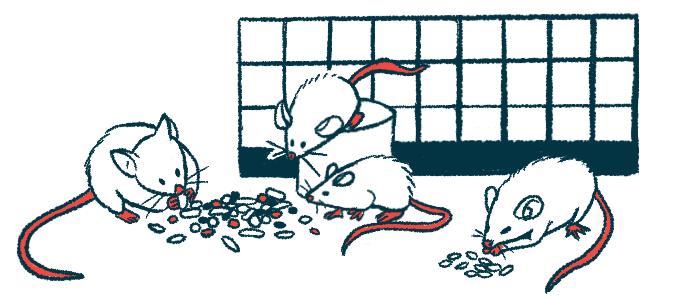Modified stem cell therapy extends survival in infantile Batten mice
In study, stem cells were modified to produce missing PPT1 enzyme

A treatment using stem cells modified to produce PPT1 — the missing enzyme in infantile Batten disease — prevented symptoms from developing and substantially extended survival in a mouse model of the disease, a study reports.
It also prolonged survival and slowed disease progression when given to mice that had already developed symptoms, “a remarkable result,” the researchers wrote in “An innovative hematopoietic stem cell gene therapy approach benefits CLN1 disease in the mouse model,” which was published in EMBO Molecular Medicine.
The findings support further studies on this therapeutic strategy, they said.
Infantile Batten, also called CLN1 disease, is a severe type of Batten disease caused by mutations in the PPT1 gene, which provides instructions for making an enzyme that helps break down complex molecules in cells.
Without a working version of the PPT1 enzyme, molecules called lipofuscins build up to toxic levels and damage cells, especially those in the brain, promoting neuroinflammation.
Within the brain, immune cells called microglia are involved in neuroinflammation and in clearing molecular waste. They may therefore be invaluable targets for treating disorders like Batten disease that feature the toxic accumulation of molecular waste.
Hematopoietic stem and progenitor cells (HSPCs) are stem cells that normally live in the bone marrow and give rise to blood cells, including most immune cells. Under the right conditions, they’re able to grow into microglia-like cells, suggesting their transplantation could restore efficient waste clearance.
Delaying symptoms, extending survival with stem cell therapy
Scientists in the U.S. and Italy tested the effects of delivering HSPCs from healthy mice directly into the bloodstream of a mouse model of infantile Batten. Before treatment, the mice were given a myeloablative regime, consisting of chemotherapy to destroy their existing HSPCs.
Compared with untreated mice, those treated with healthy HSPCs showed markedly less severe disease, as measured with a new scale devised by the researchers, results showed. They also lived significantly longer relative to untreated animals (median, 248 vs. 228 days).
“These data represent the first demonstration that [HSPC] transplantation could be beneficial in CLN1 disease,” wrote the researchers, who then tested the effects of HSPCs they genetically modified to produce higher than normal levels of the PPT1 enzyme. The new treatment led to further improvements in survival and reductions in measures of disease severity.
By day 260 (about eight months), all the untreated mice had either died or reached conditions where it was considered inhumane to keep them alive. But 77% of mice treated with the modified HSPCs were still alive. Most of them (68%) were also still alive after a year.
Analyses of the treated animals that died suggested the cause of death was usually not related to Batten. Instead, most died due to complications associated with the myeloablative regime.
Results of HSPCs via both routes of administration
The team then showed that administering the modified stem cells directly into the brain had comparable effects to the intravenous route. The best results were obtained when both routes were combined, however. Animals given the genetically modified HSPCs via both forms of administration had lower disease severity scores than those treated through only one.
At about eight months after treatment, 86% of mice given both routes were still alive and more than three-quarters (76%) lived past a year without displaying any Batten-like symptoms.
“The combinatorial transplant strategy could achieve greater … clinical benefit than the individual approaches,” the researchers wrote, noting that also tended to result in less variable outcomes.
Tissue analyses of the mice’s brain and spinal cord suggested an increase in PPT1 levels with the treatment, in many cases to levels higher than those seen in healthy mice. Again, the highest enzyme levels were achieved with the combination strategy.
Data also suggested the stem cell treatment reduced neuroinflammation.
In all these experiments, treatment was administered early in life, before the mice displayed Batten-like symptoms. In subsequent tests, the researchers gave the modified HSPCs only when the mice were about 4 months old, when symptoms start becoming apparent in this model.
“We decided to treat with the [genetically engineered HSPCs] at onset of symptoms … to verify whether we could achieve therapeutic benefit also in a stage of the disease when damage has already accumulated in the” brain and spinal cord, the researchers wrote.
The treatment diminished disease severity and extended survival also in this context — 80% of treated mice versus none of the untreated mice were alive at eight months.
The combined administration approach of modified HSPCs “results in the most robust therapeutic benefit among the tested approaches on both presymptomatic [before symptoms] as well as symptomatic animals, since it resulted in complete abrogation of the disease in a clinically relevant mouse model and determined a long-lasting and thorough prevention of symptoms,” the researchers wrote.
“Notably, this same approach could uniquely benefit adult symptomatic animals, a finding of utmost importance for translation purposes,” the researchers wrote, adding “the clinical translatability of our strategy is further supported by the favorable safety profile we showed here.”






